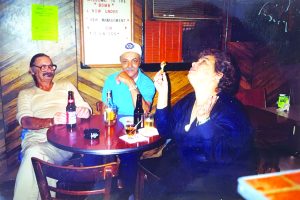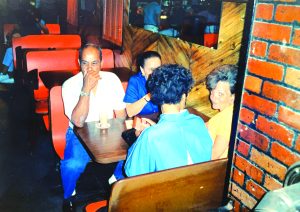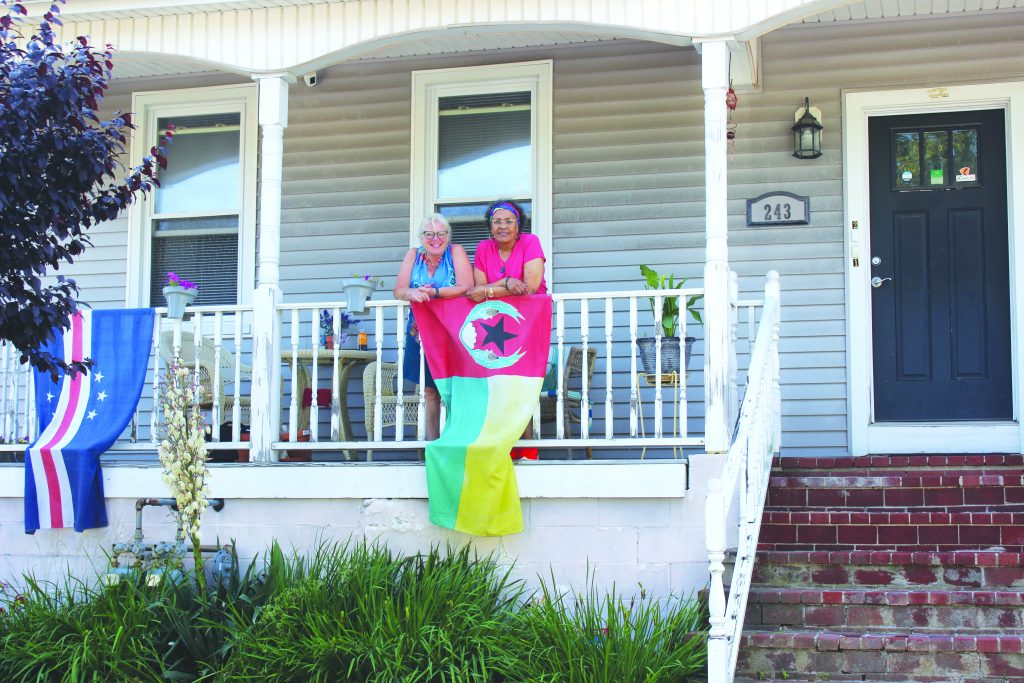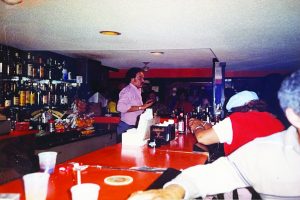Karen (Alves) Jenkins knew she was walking into history the moment she entered the unassuming New Bedford house for sale back in 2010. The Acushnet Avenue home – a two-decker with a large front porch, third-floor attic, and a side walkway leading to a separate entrance – was being sold in a lottery and getting little interest from buyers.
But Jenkins, a Cape Verdean woman who had grown up in what was then considered a South End neighborhood, knew the property’s history and what a cultural gem she’d found. She knew as soon as she entered it that day that this was the site of the beloved Cape Verdean nightclub, known to all as The Bomb Shelter, and she knew she was going to purchase the property — the home where she still lives today.
Located in a close-knit neighborhood, The Bomb Shelter was a Cape Verdean social club, a place to meet friends and play Bisca – the Portu-guese card game – and an entertainment venue and night club. Over its more than 50-year run, people of all ages and cultures came and went regularly including many Cape Verdeans from the New Bedford and Providence areas as well as all over the country.
Despite being located in the basement of the home of a Cape Verdean immigrant and businessman, people found their way to it.
“Everybody knew of The Bomb Shelter,” said Frank Pina, a New Bedford photographer and son of the club’s creator. “You’d have people in the summer that were visiting from California or other states all looking for the Bomb Shelter.”

Pina’s father, Alfred “Néné” Pina, started the Bomb Shelter in the 1940s. He had come to New Bedford from Cape Verde as a teenager, worked hard, started a family and soon owned property that he rented to others. Néné Pina quickly became a business leader in the community, an enthusiastic follower of city and national politics, and a popular and respected local figure despite never having gone to school, according to Pina.
“I can honestly say that he was my lifetime hero,” he said as he reminisced about his youth and growing up two floors above the social club.
Pina said his father purchased the Acushnet Avenue house in the 1930s to be the family home. The basement was first used as a space for band practice and later became a political club before transforming into the popular Cape Verdean social club.
Néné was the club’s driving force. He ran the business and served as its social director, chatting with people who came in, keeping the club running smoothly, and personally handling any simmering arguments or fights before they could escalate.
“My dad would visit a booth and talk with them for a while before getting up and ordering a round of drinks for them,” recalled Pina. “He was very social, and everybody loved him. He was the heart and soul of (the club).”
The club’s name came from the creation of city shelters during World War II. “Different buildings were designated as a shelter in case we got bombed,” said Pina. “That’s how it got its name and the name stuck long after the war was over.”
Many local bands played there. Most notable, Pina said, was Feliciano Vierra Tavares Sr., known professionally as Flash Tavares and the patriarch of the successful Tavares Brothers.
“His children weren’t even heard of at the time,” Pina said.
Pina knew the club well. As a youth, he was paid $1 for three hours of work cleaning the space, a task he disliked, he said, especially having to pick up cigarette butts off the floor. As he got older, Pina worked there as a waiter and bartender.
“It was a tight, close neighborhood, and I had a beautiful childhood,” he said. “Especially because I had a great mom and dad.”
(My dad) used to rub your head at the dinner table and tell you how much you mean to him,” he continued, pausing for a moment before adding, “But he was still a disciplinarian.”
Pina couldn’t pinpoint the date the Bomb Shelter closed because his family sold it while it was still being operated.
“I don’t know what they did with it,” he said about the new owners. “It was never the same. It was like a family. Everybody went there and they enjoyed themselves. You never had to worry about getting hurt.”

Although her answer was that she wasn’t, Jenkins understood the emotions behind the requests and how a shared social space like the Bomb Shelter contributes to the vibrancy and health of a neighborhood.
She remembers how the construction of Route 18 had split apart her neighborhood. “It was called the highway to nowhere,” she said. “They displaced so many people and didn’t develop anything.”
She’s worried that recent signs of gentrification will also do damage to the neighborhood and has joined the Healthy Neighborhoods Study being conducted by MIT and the YMCA SouthCoast to help keep community ties strong.
The project is based in Boston through the Department of Urban Studies and Planning at MIT and is the largest resident-driven, participatory action research project in the US about neighborhood change processes, including gentrification and climate change, according to the project website.
Jenkins is one of local residents who contribute to the study in New Bedford as is Gail Roderigues at the YMCA SouthCoast.
Roderigues shared some of the findings that the HNS study revealed about the health of the New Bedford neighborhood.
“The HNS findings reveal that residents of the neighborhood overwhelmingly expressed their desire to remain in the area. However, this decision is not driven by their personal choice but rather by concerns about the potential for displacement and gentrification,” Roderigues said via email. “This suggests that residents are attached to their community and wish to stay but feel compelled to do so due to external factors that could threaten their ability to remain in the neighborhood.”
In her own statement, Jenkins articulated her hopes for the house where the Bomb Shelter operated as well as the neighborhood’s Cape Verdean culture and future generations living there.
“As a resident of my childhood neighborhood for the past 13 years, this home has become the embodiment of my connection to my heritage and my identity. In a community deeply ingrained in Cape Verdean culture and history, I stand as a legacy resident alongside many others who have witnessed the neighborhood’s evolution,” she wrote. “I harbor a deep desire to ensure that my children understand the historical significance of this home and the community it resides.”
As part of her work, Jenkins opened her basement to the community last spring with Roderigues’ and Pina’s help, to let people come together and reminisce about the club, their experiences there, and the impact the space and people had on their lives. It was a chance to recapture the feeling of community, she said, and address some of the negative changes that have been happening locally, including signs of gentrification.
The event was a success.
“It was beautiful and just fun to be in that environment and remember the low-ceiling and the way the bar was,” said Pina. “Of course, it doesn’t exist anymore but just knowing you’re in that building was special.”
Jenkins and Pina acknowledge The Bomb Shelter is gone forever. The bar and seats were removed long ago and the space no longer resembles its glory days. But the club lives on in memories.
“It’s just the end of an era and you have to respect what happened there and remember it until it’s forgotten,” Pina said.
Anyone interested in a copy of the book can email or call groderigues@ ymcasc.org or 774-526-2651.



Recent Comments